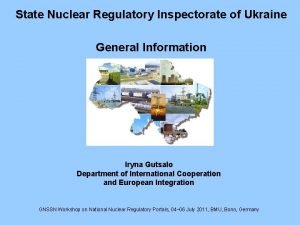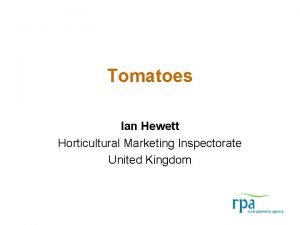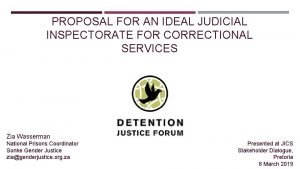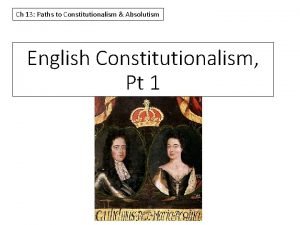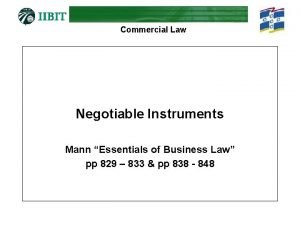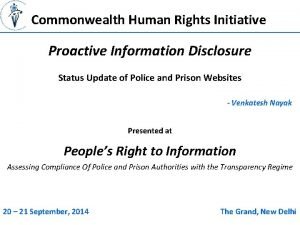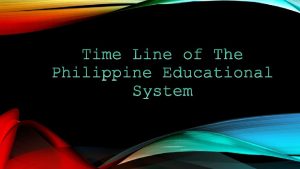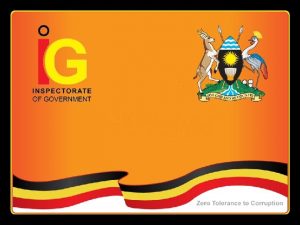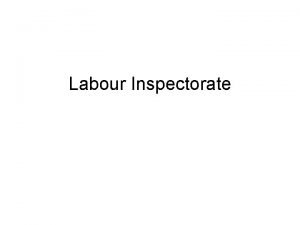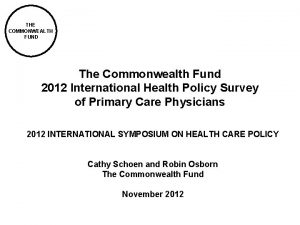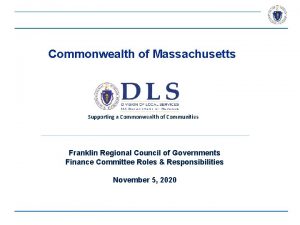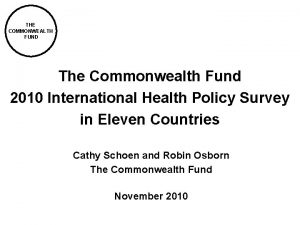INSPECTORATE OF GOVERNMENT 9 th Commonwealth Regional Conference




















- Slides: 20


INSPECTORATE OF GOVERNMENT 9 th Commonwealth Regional Conference for Heads of Anti-Corruption Agencies in Commonwealth Africa Uganda Country Report INSPECTOR GENERAL OF GOVERNMENT 7 th May 2019

Commitment to Fight against corruption dates back to liberation struggle. Point Number Seven (7) of the Ten Point Programme) Elimination of corruption and prevention of the misuse of power. First IGG appointed to head a Department in Office of the President in 1986. IGG to eliminate corruption and ensure protection of Human Rights. Subsequently, elevated to a Statutory Body with the enactment of the Inspectorate of Government Statute in 1988. The 1995 Constitution births three core functions namely - Anti-Corruption, Ombudsman and Enforcement of Leadership Code of conduct

Background Ø Commitment to Fight against corruption dates back to liberation struggle. Ø Point Number Seven (7) of the Ten Point Programme) Ø Elimination of corruption and prevention of the misuse of power. Ø First IGG appointed to head a Department in Office of the President in 1986. Ø IGG to eliminate corruption and ensure protection of Human Rights. Subsequently, elevated to a Statutory Body with the enactment of the Inspectorate of Government Statute in 1988. Ø The 1995 Constitution births three core functions namely - Anti-Corruption, Ombudsman and Enforcement of Leadership Code of conduct

Legal Framework Ø IG is established under Chapter 13 of the Constitution of the Republic of Uganda and the Inspectorate of Government Act No. 5 of 2002. Ø IG is one of the key institutions through which the Government of Uganda fulfils Objective XXVI of the National Objectives and Directive Principles of State Policy enshrined in the Constitution of Uganda: 1. All public offices shall be held in trust for the people. 2. All persons placed in positions of leadership and responsibility shall in their work, be answerable to the people. 3. All lawful measures shall be taken to expose, combat and eradicate corruption and abuse or misuse of power by those holding political and other public offices.

MANDATE, VISION & MISSION OF THE INSPECTORATE Mandate: Promoting just utilization of Public Resources Vision: Responsive and Accountable Public Sector Mission: To promote Good Governance, Accountability and the Rule of Law in Public offices

Composition The Inspectorate of Government, which comprises the Inspector General of Government (Justice Irene Mulyagonja Kakooza) and two Deputy Inspectors General of Government, Ms. F. Mariam Wangadya and myself wears three ‘hats’ in the execution of this mandate: 1. The Ombudsman hat: to promote and foster strict adherence to the rule of law and principles of natural justice in administration; 2. Anti-Corruption hat: to eliminate and foster the elimination of corruption, and 3. Leadership Code hat: to enforce the implementation of the Leadership Code Act,

Strategic Plan

Case of Northern Uganda Social Action Fund NUSAF) Government of Uganda implemented the 1 st phase of the Northern Uganda Social Action Fund (NUSAF 1) project from 2003 - 2009. It was implemented in 56 districts using USD 100 M borrowed from the World Bank. Project Implementation Unit Approach was used. There were a number of challenges registered during the implementation of NUSAF 1. These included: Poor Accountability Shoddy work Incomplete projects Non-existent work As a result of the above challenges, Government had to refund approximately USD 1. 3 m to World Bank at the end of the project period

IG involvement in NUSAF During the design of NUSAF 2, which was also funded by the World bank to a tune of USD 100 m, the IG was brought to strengthen governance issues. One of changes brought in by IG at that time was to ensure that the project was mainstreamed into the government structure. In addition, the Inspectorate of Government implemented the Transparency, Accountability and Anti-corruption (TAAC) sub-component of the Second Northern Uganda Social Action Fund Project (NUSAF 2) INDEPENDENTLY. The objective of TAAC was “to promote good governance at all levels of project implementation”.

Interventions of IG in NUSAF In order to achieve the objective of TAAC, the Inspectorate used both preventive and enforcement measures. These were: Education and awareness. Involvement and participation of all the stakeholders and in particular citizens which enabled quick detection and quick fixing to pre-empt any wastage, leakages or diversion of project funds Monitoring and inspection Enforcement through investigation and prosecution. NB: Enforcement was last resort.

Citizen Engagement During the implementation of TAAC, Citizen engagement was key in ensuring transparency and accountability. Thus the Social Accountability and Community Monitoring Activity was introduced with the objective of “Empowering citizens to Monitor Government projects”. This involved training communities on: How to monitor Government projects How to document findings from monitoring activities How and where to report corruption The IG collaborated with 10 Civil Society Organizations to train the community groups who included Social Accountability committees (SACs) and members of Community Monitoring Groups (CMGs). They were all volunteers and were not paid. Approximately 60, 000 ( 53, 500 SACs and 6, 500 CMGs) citizens were empowered to provide oversight in the implementation 10, 000 subprojects in the 56 NUSAF 2 Districts. However, 6. 500 members of CMGs received targeted training and were required to report back to the Inspectorate of Government on their activities. They also received badges for identification.

Achievements As a result of the above interventions, the following achievements were registered: 1. Extent of corruption and mal-administration at Central Government, Local Government and at the community levels was greatly minimized due to increased awareness, routine monitoring and inspection which led to early detection and quick fixing of any anomalies. e. g. Some of the funds saved include but not limited to funds for Buliisa District UGX 119 million; Maracha District UGX 234 million and Kumi District UGX 855 million; Amudat 46 million; Tororo 6 million 2. Financial accountability of up to 99. 9% at the end of the project implementation was realized as a result of working with the various stakeholders closely. 3. Operational challenges were resolved expeditiously leading to timely implementation of the Sub-projects: e. g. We made contractors resume work in Kaboong, Bukedea and Lamwo Districts after our intervention.

Achievements 4. Absorption rate of 100% of the Project funds. 5. Improved quality of the project output 6. Inspected and monitored over 10, 000 Sub-projects. 7. Through the Social Accountability and Community Monitoring Activity, over 100, 000 members of the communities were mobilised and empowered to monitor the sub- projects and to demand for Accountability. 8. Value for money registered in project implementation. In Bukedea District, we discovered 6 teachers houses roofed with iron sheet of gauge 28 instead of 26 inches. 9. Improved coordination between MDA/LGs , CSOs and IG

The TAAC sub-component was an example of how to mainstream Citizen Engagement in large -scale operations and this has been emulated in other social protection programs. Government has pronounced itself based on the above achievements, the importance of mainstreaming citizen engagement.

The role of IG in NUSAF 3 Following the successful implementation of NUSAF 2, the Inspectorate of Government is currently implementing the ‘Strengthening the transparency, accountability and anticorruption’ (STAAC) component of NUSAF 3. STAAC is tailored to contribute to the Government priority for improved transparency and accountability in public service delivery as enshrined in the vision 2040, the NDP and the Accountability Sector Strategic Investment Plan (ASSIP).

Objective of STAAC will enhance effectiveness of transparency, accountability and Anti. Corruption processes in the project areas; One of the key areas of intervention is Enhancing the engagement of citizens and stakeholders

CRETA Citizens and stakeholders engagement has been enhanced through “Citizen Responsibility to enhance Transparency and Accountability, CRETA” IV) The overall objective of the CRETA activity is ‘to build the capacity of Community Monitoring Groups (CMGs) to enhance community responsibility, transparency and accountability in the implementation of the NUSAF III subprojects and other government programs. ’ Implemented through: IV) collaboration with 33 CSOs to provide training , supervision and follow up in the communities. V) Develop Social accountability tools like the Community Score Card to provide feedback on service delivery. VI) Establish grievance handling mechanisms for management of grievances at all levels of project implementation and introduce a register for tracking grievances at all levels.

IG activities under STAAC § Enhancing the engagement of citizens and stakeholders cont’d IV) Community Monitoring Groups (CMGs) was upgraded and expanded to the Parish level. The members of the group comprise representative at the village level. The mandate and operation includes general oversight, monitoring of activities being implemented, handling of complaints and appeals at the first instance and ensuring implementers are operating transparently. The members of the CMGs are empowered to monitor all government projects and activities. The CMGs are trained on how to monitor, how to document, management of grievances, reporting corruption among others. V) The IG will strengthen existing mechanisms for reporting corruption through SMS so that it is user friendly.

CRETA IV) strengthen functionality of community level committees to support achievement of the component and project objectives
 Commonwealth local government forum
Commonwealth local government forum Pharmaceutical inspectorate
Pharmaceutical inspectorate State nuclear regulatory inspectorate
State nuclear regulatory inspectorate Horticultural marketing inspectorate
Horticultural marketing inspectorate Correctional nursing
Correctional nursing Timis county school inspectorate
Timis county school inspectorate Factory inspectorate
Factory inspectorate Nacada regional conference
Nacada regional conference What are the three levels of government
What are the three levels of government Meaning of commonwealth countries
Meaning of commonwealth countries Commonwealth
Commonwealth Ccc waiver
Ccc waiver Workplace readiness skills for the commonwealth
Workplace readiness skills for the commonwealth Commonwealth population
Commonwealth population Commonwealth bank not negotiable cheque
Commonwealth bank not negotiable cheque Commonwealth exchange programme
Commonwealth exchange programme Proactive commonwealth
Proactive commonwealth Republic act no 5250
Republic act no 5250 Workplace readiness skills
Workplace readiness skills Virginia workplace readiness skills
Virginia workplace readiness skills Commonwealth connector
Commonwealth connector


